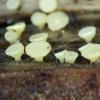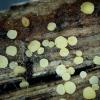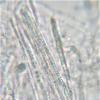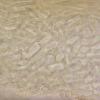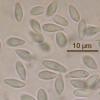
22-04-2025 21:46
 Francois Guay
Francois Guay
I found this strange "discomycete" three days ago,

22-04-2025 10:37
François BartholomeeusenAlso found on April 18, 2025 on an old seed-pod of

22-04-2025 09:35
François BartholomeeusenDear forum members, Can someone help me!On April

29-03-2025 05:45
Sebastien BassoHello, I'm conducting a mycological inventory in

19-04-2025 20:48
Dear Ascofrance. I have not posted pyrenos for a l

19-04-2025 08:51
Henri KoskinenCould you help me in the right direction with this
Bisporella like
Yannick Mourgues,
30-01-2009 00:30
 Hi.
Hi.Here is a specie near B. subpallida. I need your help to know if it's right or wrong.
Macro:
ap. bright yellow, short-stalked, on rotten wood of Fagus or Fraxinus (difficult to know), diam.<0,5 mm. reddening when dammaged.
Micro:
Sp. scutuloid, 6,5-7,6x3-3,3 µm, no septate, Q=2-2,4, with 2 small guttules at each end.
Paraph. with refractive vacuoles <1 µm , Paraph. 1 septate, green inside in Lugol, l<2 µm.
Asc. IKI+ (very difficult to see..., so may be IKI-), croziers +, 70-100x4-6 µm.
What do you think about that ?
Yannick
Richard Korf,
30-01-2009 00:55
Re:Bisporella like
Surely looks like a Bisporella, but that may be a MUCH larger genus than anyone has expected. We have no monograph (that I know of).
Guy Garcia,
30-01-2009 11:50
Re:Bisporella like
Faudrait vérifier si l'excipulum réagit en bleu ciel avec le lugol ou le melzer, ce qui est le cas pour Bisporella subpallida. Si la réaction est négative; voir du côté de Bisporella rubescens.
Comme Dick le signale le genre Bisporella est assez confus. De plus, de nombreux taxons publiés entre autres dans le genre Calycella pourraient trouver leur place chez les Bisporella.
Vérifie aussi la structure de l'excipulum qui est caractérsitique dans le genre Bisporella : textura oblita (gélification).
Bon courage.
Amitiés, Guy
Comme Dick le signale le genre Bisporella est assez confus. De plus, de nombreux taxons publiés entre autres dans le genre Calycella pourraient trouver leur place chez les Bisporella.
Vérifie aussi la structure de l'excipulum qui est caractérsitique dans le genre Bisporella : textura oblita (gélification).
Bon courage.
Amitiés, Guy
Hans-Otto Baral,
30-01-2009 17:56

Re:Bisporella like
Guy is right, I would also look for the blue excipulum reaction (maybe only at the apothecial base) and believe that this is B. subpallida. I think, however, that Bisporella is heterogeneous. I only recognize two species in Bisporella s.str., B. subpallida and the type, B. pallescsens. Both have multiguttulate paraphyses and a Hymenoscyphus-type of ascus apex (quite faintly reacting, very different from the Calycina-type in "Bisporella" citrina and others which are surely closer to or even conspecific with Calycina. I remember that molecular data have proven this view.
I attach some images of a recent find (on Salix wood, Chemnitz).
Zotto
I attach some images of a recent find (on Salix wood, Chemnitz).
Zotto
Hans-Otto Baral,
30-01-2009 17:56
Yannick Mourgues,
30-01-2009 21:29

Re:Bisporella like
Bonsoir et merci à tous les deux.
Je viens de vérifier la réaction d'une coupe dans le Lugol, et l'excipulum réagit bien en bleu.
La textura est bien oblita comme vous l'avez dit.
Je peux donc conclure pour Bisporella subpallida ?
I have just checked the blue excipulum reaction and it's positive.
Textura is oblita.
So can I conclude for Bisporella subpallida ?
Avez-vous déjà constaté que :
1. les apothécies deviennent rouges à la blessure ?
2. le contenu des paraphyse devient vert dans le Lugol ?
Have you ever noted that :
1. apo. are reddening when dammaged ?
2. paraph. becomes green inside with Lugol ?
Thank's a lot.
Yannick
Je viens de vérifier la réaction d'une coupe dans le Lugol, et l'excipulum réagit bien en bleu.
La textura est bien oblita comme vous l'avez dit.
Je peux donc conclure pour Bisporella subpallida ?
I have just checked the blue excipulum reaction and it's positive.
Textura is oblita.
So can I conclude for Bisporella subpallida ?
Avez-vous déjà constaté que :
1. les apothécies deviennent rouges à la blessure ?
2. le contenu des paraphyse devient vert dans le Lugol ?
Have you ever noted that :
1. apo. are reddening when dammaged ?
2. paraph. becomes green inside with Lugol ?
Thank's a lot.
Yannick
Guy Garcia,
30-01-2009 22:44
Re:Bisporella like
Personnellement je n'ai étudié que 2 récoltes de Bisporella subpallida (dont une de Gérard Trichies) et je n'ai pas souvenir ni noté un verdissement du contenu des paraphyses dans le lugol ? Mais, il me semble, à la vue de ta photo, que ton récatif doit être très concentré !
Quant au rougissement voir la fiche de récolte HB 6069E (sur DVD de Zotto).
Quant au rougissement voir la fiche de récolte HB 6069E (sur DVD de Zotto).
Yannick Mourgues,
30-01-2009 22:52

Re:Bisporella like
Ok, merci pour ces précisions.
Amitiés.
Yannick
Amitiés.
Yannick
Hans-Otto Baral,
30-01-2009 23:33

Re:Bisporella like
Oh yes, Guy, that 6069 is a third apparently true Bisporella, though it resembles also Hymenoscyphus kathiae, were not the strong oblita. Yes, this reddening is due to an oxidation process of the VBs (paraphysis vacuolar guttules).
No, I also cannot remember to have seen a greenish reaction in IKI. Usually one gets a yellowish to red-brown reaction of VBs in IKI.
Zotto
No, I also cannot remember to have seen a greenish reaction in IKI. Usually one gets a yellowish to red-brown reaction of VBs in IKI.
Zotto
Yannick Mourgues,
30-01-2009 23:35

Re:Bisporella like
Thank's Zotto !
Yannick
Yannick


